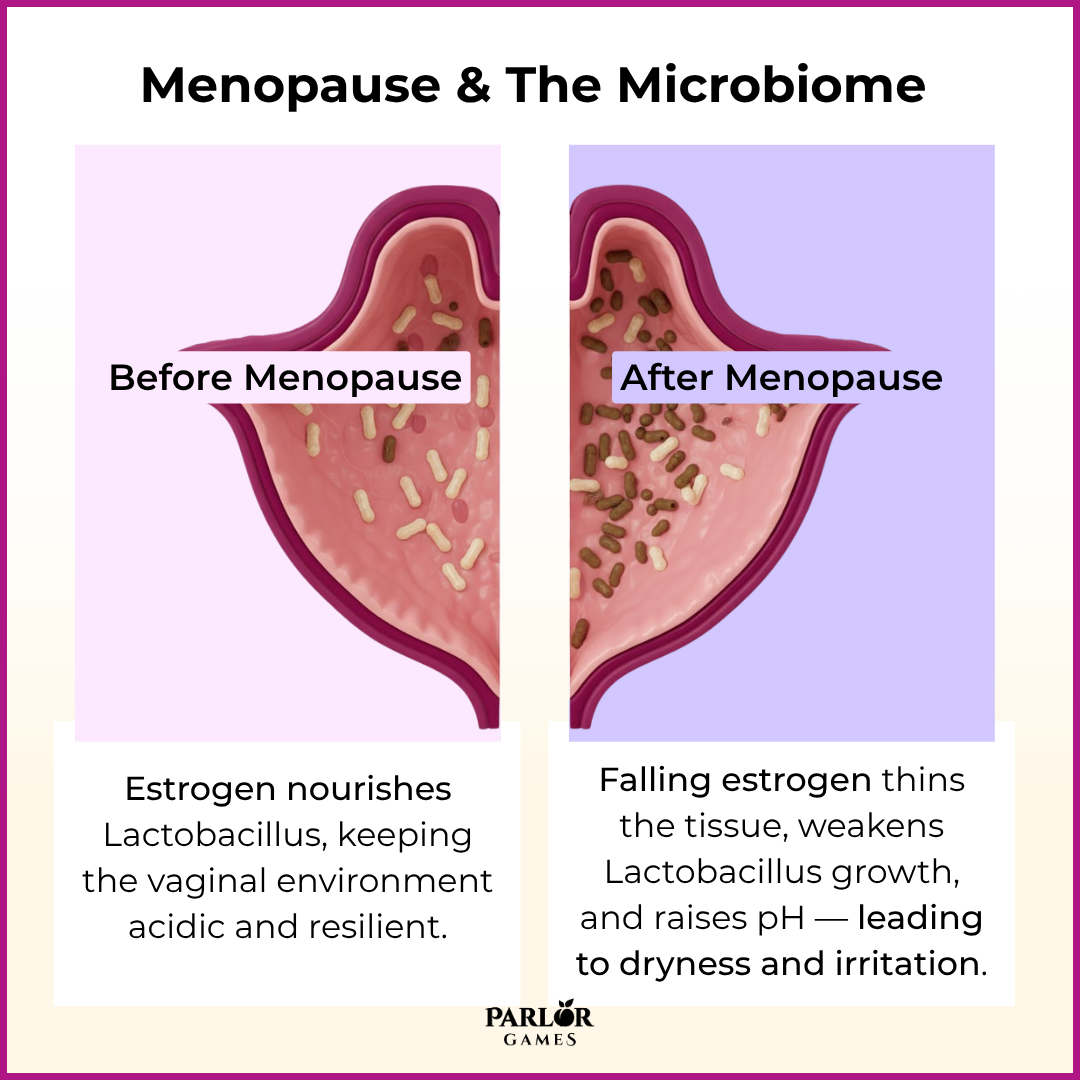CLICK TO SHOP OUR BLACK FRIDAY SALE!
*Excludes BioNude and subscriptions

Menopause reshapes the vaginal ecosystem: as ovarian estrogen falls the vaginal lining thins, makes less glycogen (the sugar that feeds protective Lactobacillus bacteria), and the environment becomes less acidic — changes that lead to dryness, irritation, painful sex and more frequent infections, collectively known as genitourinary syndrome of menopause (GSM). This study walked through the biology behind those shifts in plain language and explain what treatments - especially local vaginal estrogen and sensible non-hormonal options - can do to restore tissue health and the protective bacterial community.
When ovarian estrogen falls in menopause, the vaginal lining thins and makes less glycogen (the sugar that feeds protective Lactobacillus bacteria). Without that food source, Lactobacillus often declines and the vaginal bacterial community becomes more diverse — which raises vaginal pH and weakens the natural acidic barrier.
Those tissue and microbiome changes are closely linked to the symptoms many people experience and call genitourinary syndrome of menopause (GSM): vaginal dryness, burning, pain with intercourse, and more frequent yeast or bacterial infections. In other words, these problems aren’t just “normal aging” — they reflect measurable shifts in local biology.
Applying estrogen locally inside the vagina (vaginal or local estrogen) reliably improves tissue health, restores glycogen production, lowers pH, and often brings back Lactobacillus dominance — with clear symptom relief for many women. Non-hormonal options (moisturizers, lubricants, pH-balancing products, and some probiotic approaches) can ease symptoms and are useful when hormones aren’t appropriate, but the evidence that they consistently rebuild a protective microbiome is weaker and more mixed.
Key takeaways
View the study here: https://www.sciencedirect.com/science/article/abs/pii/S0378512216301244

Lorem ipsum dolor sit amet, consectetur adipiscing elit.
Lorem ipsum dolor sit amet, consectetur adipiscing elit.
Lorem ipsum dolor sit amet, consectetur adipiscing elit.
Lorem ipsum dolor sit amet, consectetur adipiscing elit.
Disclaimer: The information provided above is intended for educational and informational purposes only. Statements made have not been evaluated by the FDA nor are they intended to treat or diagnose. Any health concerns should be discussed and evaluated by your primary health care provider.
Parlor Games, LLC ● kate@parlor-games.com ● 5304 River Rd N Ste B ● Keizer OR 97303
Disclaimer: The information provided above is intended for educational and informational purposes only. Statements made have not been evaluated by the FDA nor are they intended to treat or diagnose. Any health concerns should be discussed and evaluated by your primary health care provider.
28 Day Challenge Subscription Details

We ship you a 28 day supply of Silky Peach Cream for only $29 (more than 25% off our normal price) when you sign up for Subscribe & Save.
Follow the directions we include in the package and apply Silky Peach cream on your tender bits for 28 days.

Decision Day:
5 days before your subscription rebills, we’ll send you an email reminder with a link. If you decide Silky Peach is nice but not your thing… you can click that link and cancel your subscription without even talking to anyone. No hassle — no questions asked.
If you are like 72% of our Silky Peach customers, you’ll love it and can't imagine life without it. In that case, do nothing, and we’ll welcome you to the Parlor Games family and ship Silky Peach Cream to your door step every month for the same discounted price of $29 — locked in for as long as you remain a subscriber.

Important note about our easy-breezy subscriptions:
We know that some companies make it hard to cancel a subscription — that’s not us. Our mission is to save the world — one vagina at a time! If you decide you don’t need Estriol as an ongoing solution for dryness, incontinence, UTIs and keeping sex fun and comfortable again, we understand. Five days before we ship your next order, you'll receive an email with a link to cancel right there in the message.
No hunting, no searching, we got you. Respect is where it’s at.
FYI – Estriol is beneficial for skin integrity and mucous membranes. It’s great for vaginal atrophy and also amazing for use on the face and neck. Applying a small amount — about 1 pump — can help build the collagen and plump up the cells to reduce wrinkles. Who knew!!
OUR HAPPINESS GUARANTEE
We want you to feel safe and confident trying any of our products. That's why we promise 100% money-back guarantee on the purchase price of the first bottle of any of our products. Balancing hormones DOES take some time, so please try it for 28 days. If after 28 days you are unhappy, or the product just hasn't worked for you, simply contact us and we'll process a refund of your full purchase price upon receipt. Sorry, shipping fees are not refundable.